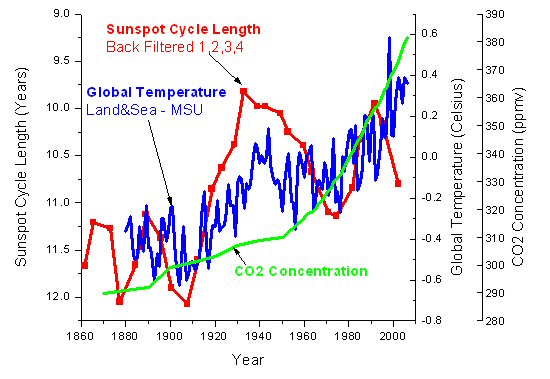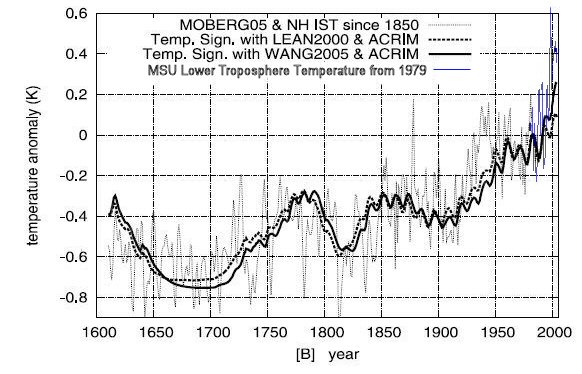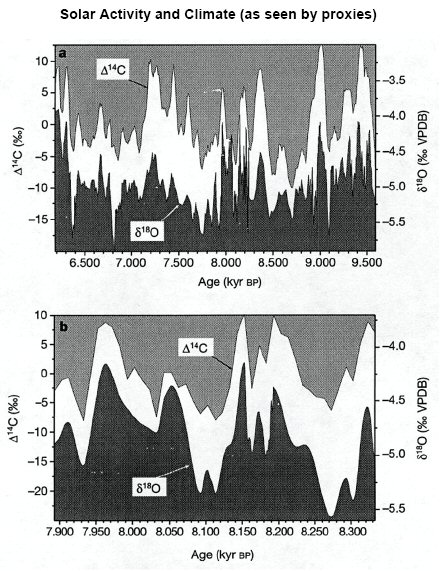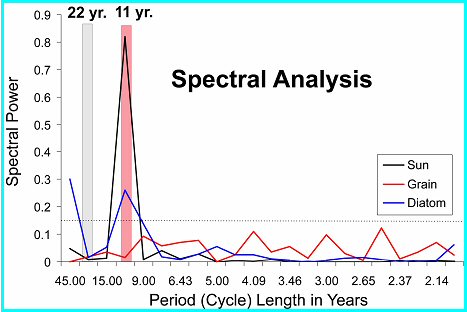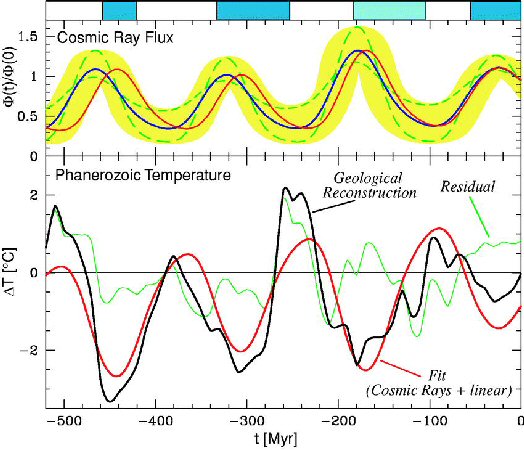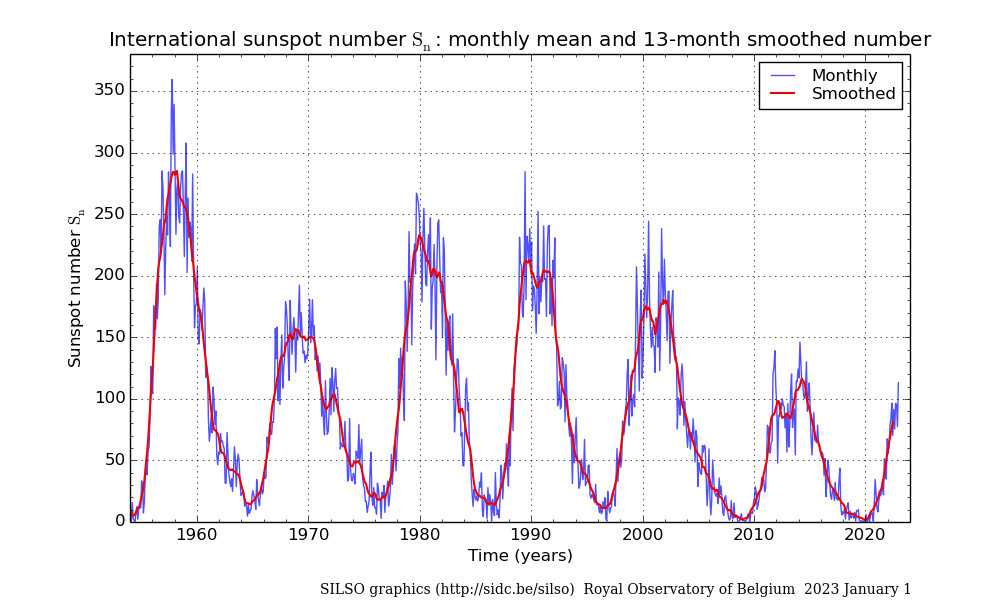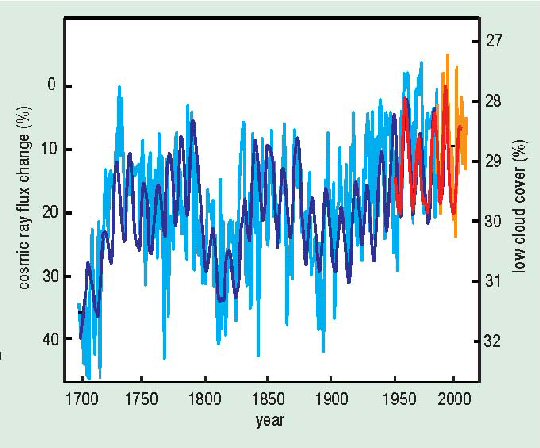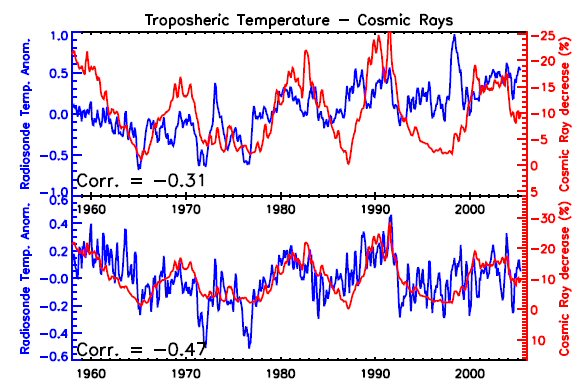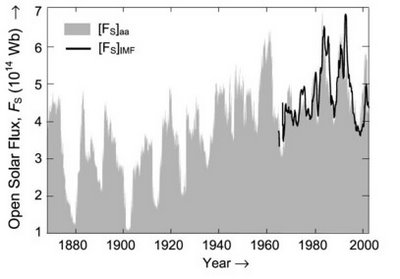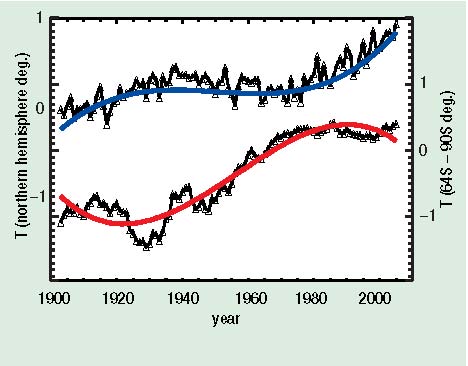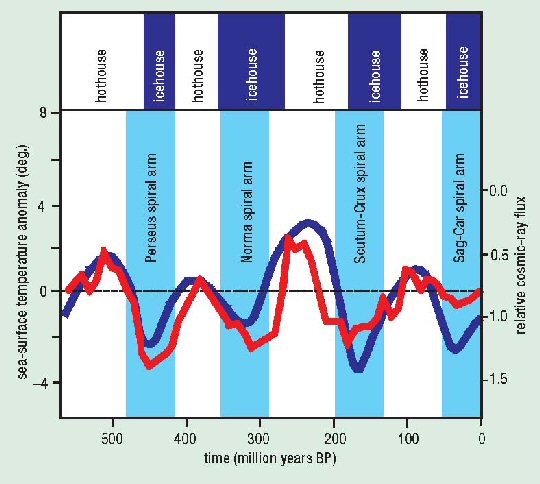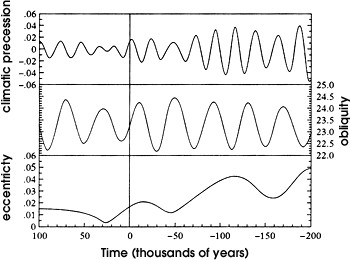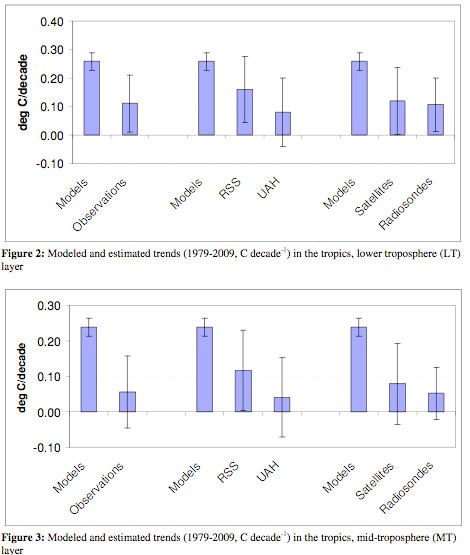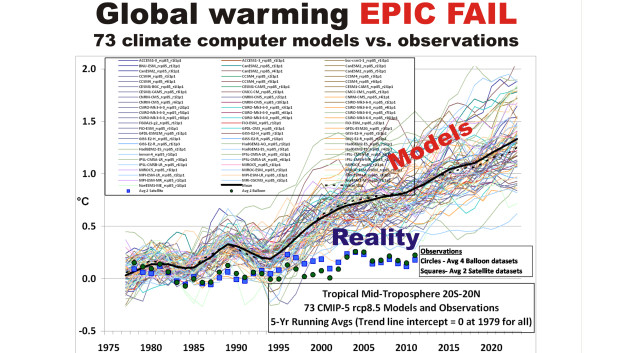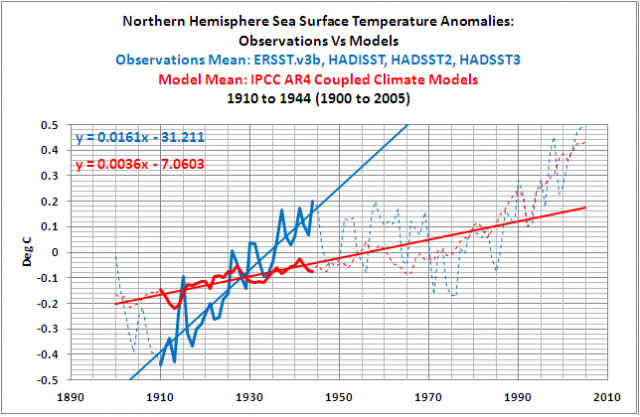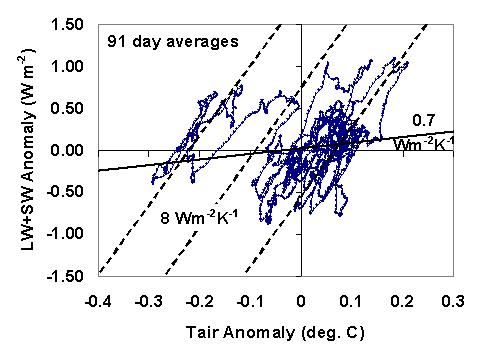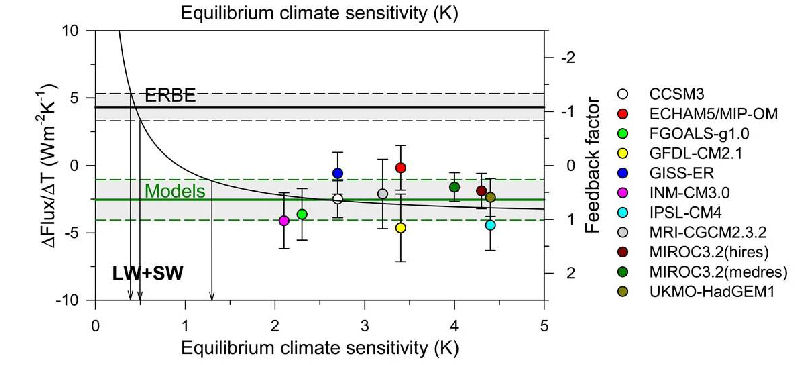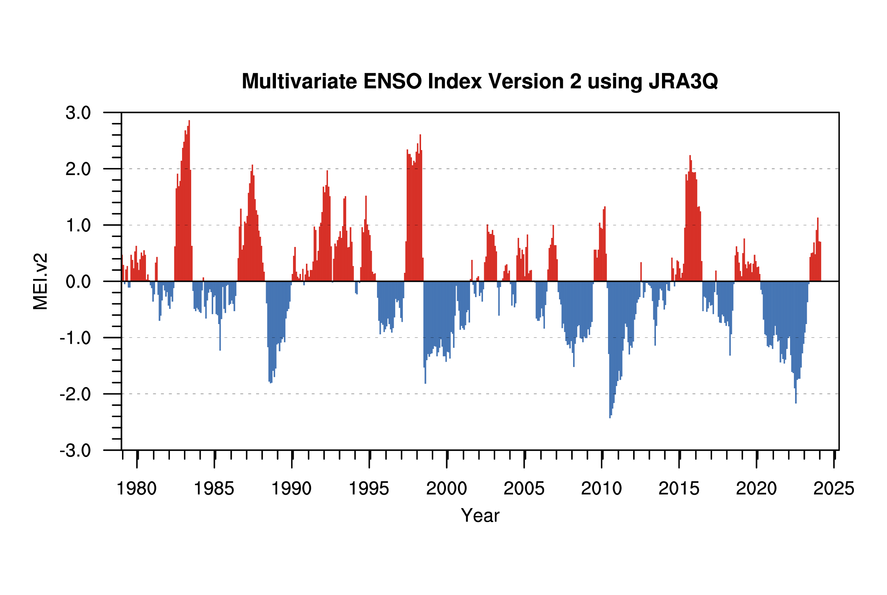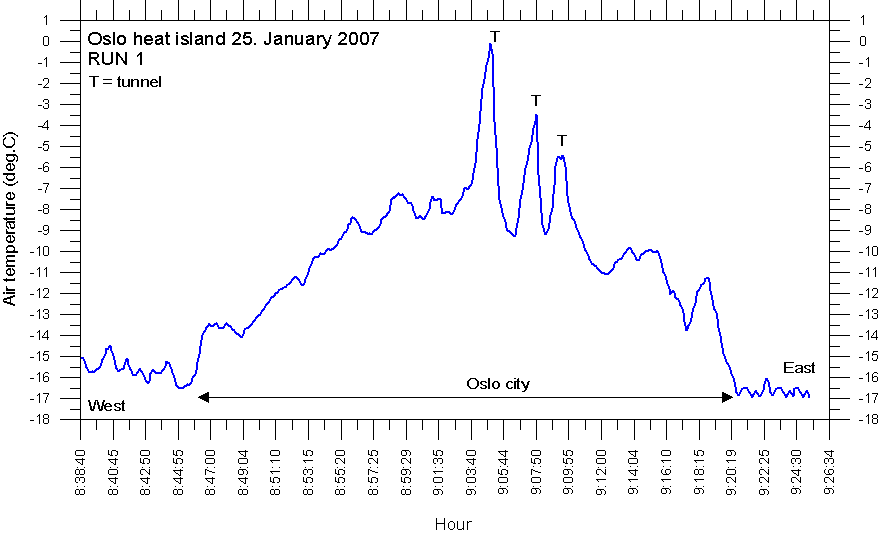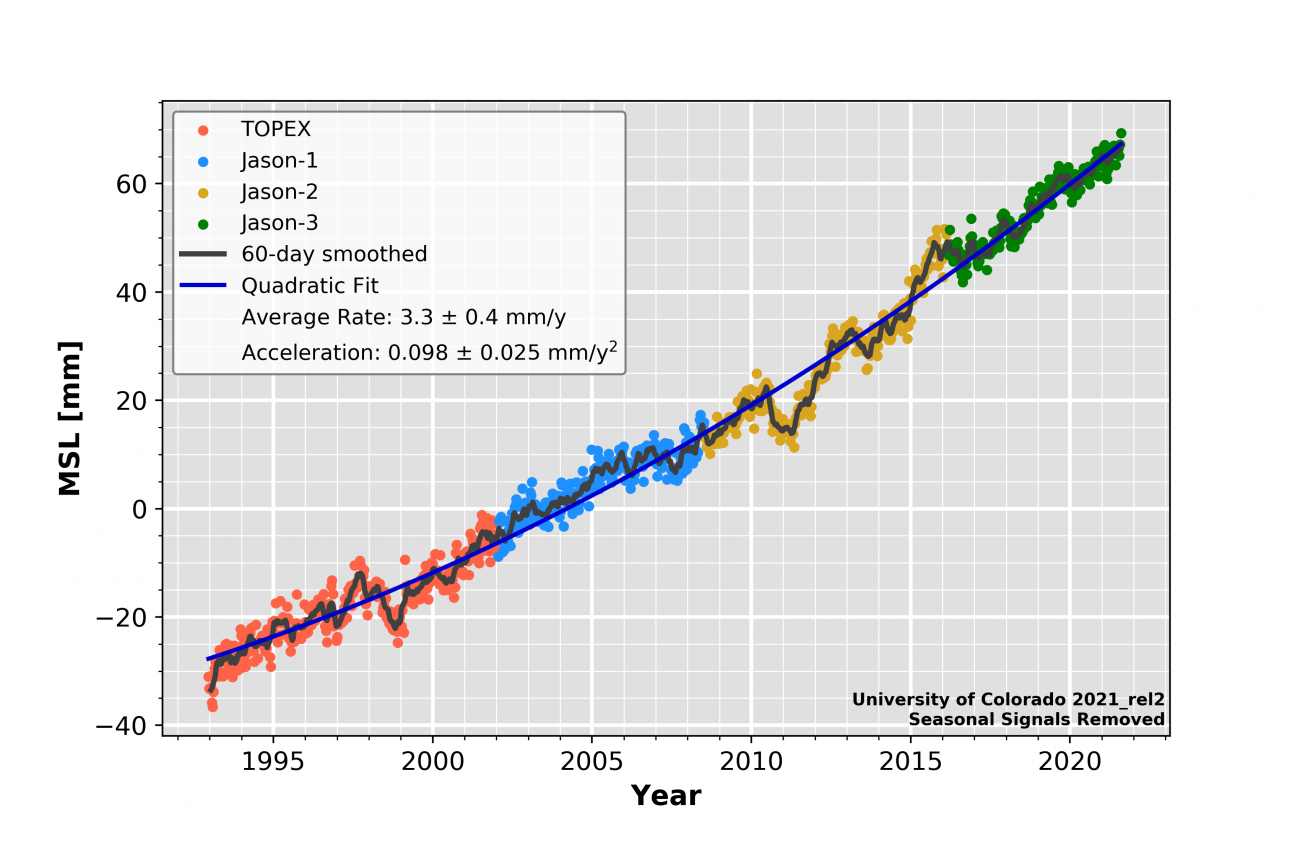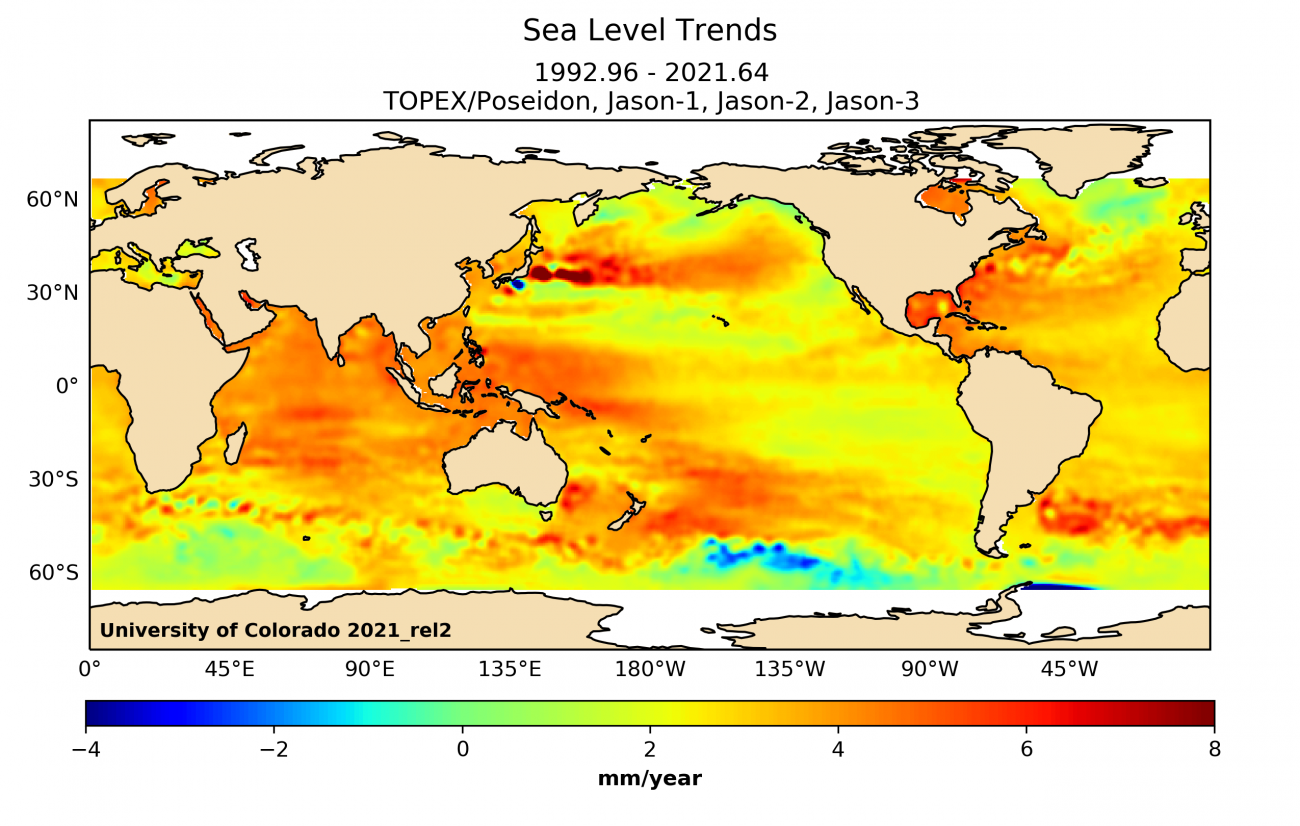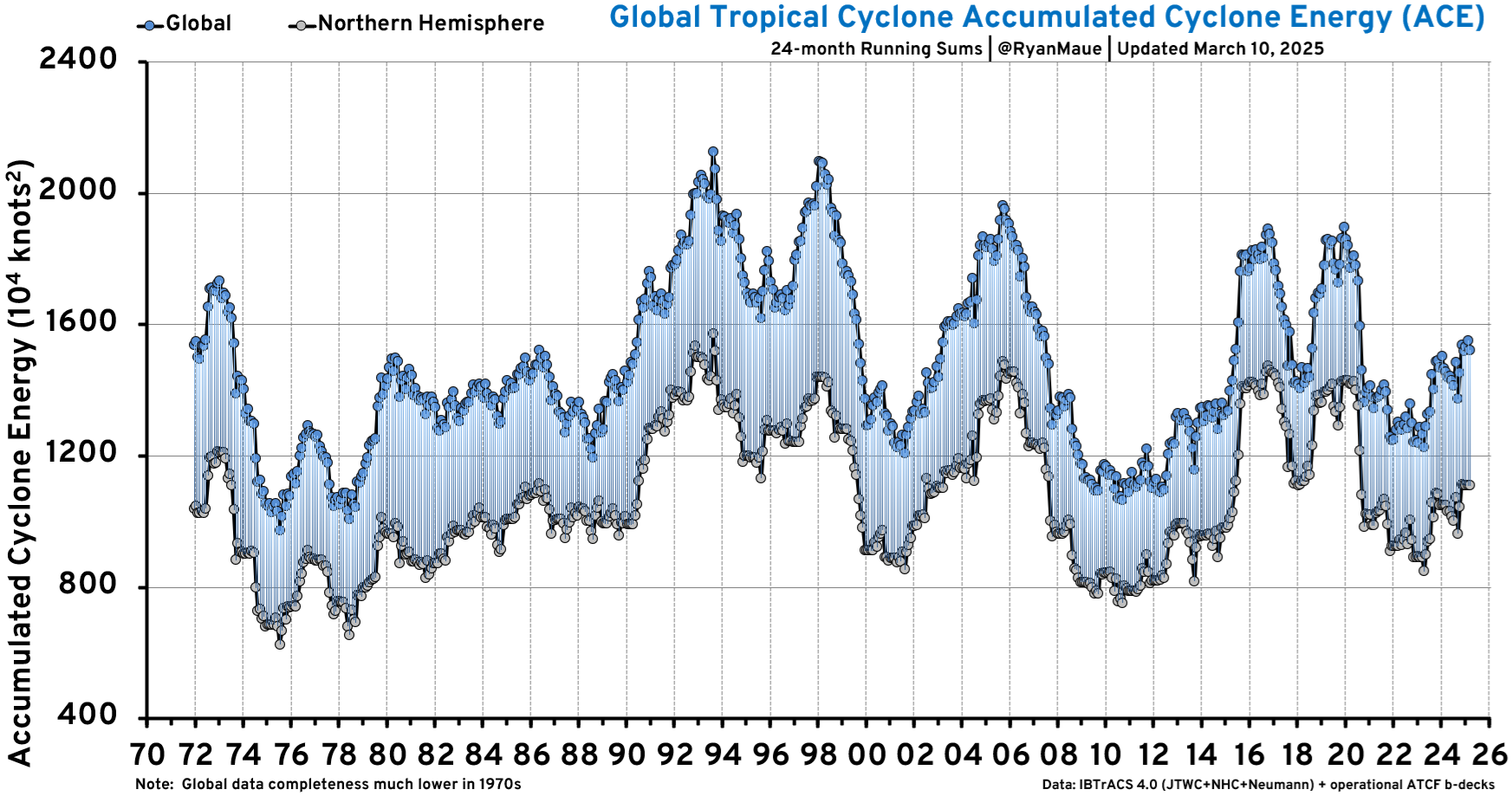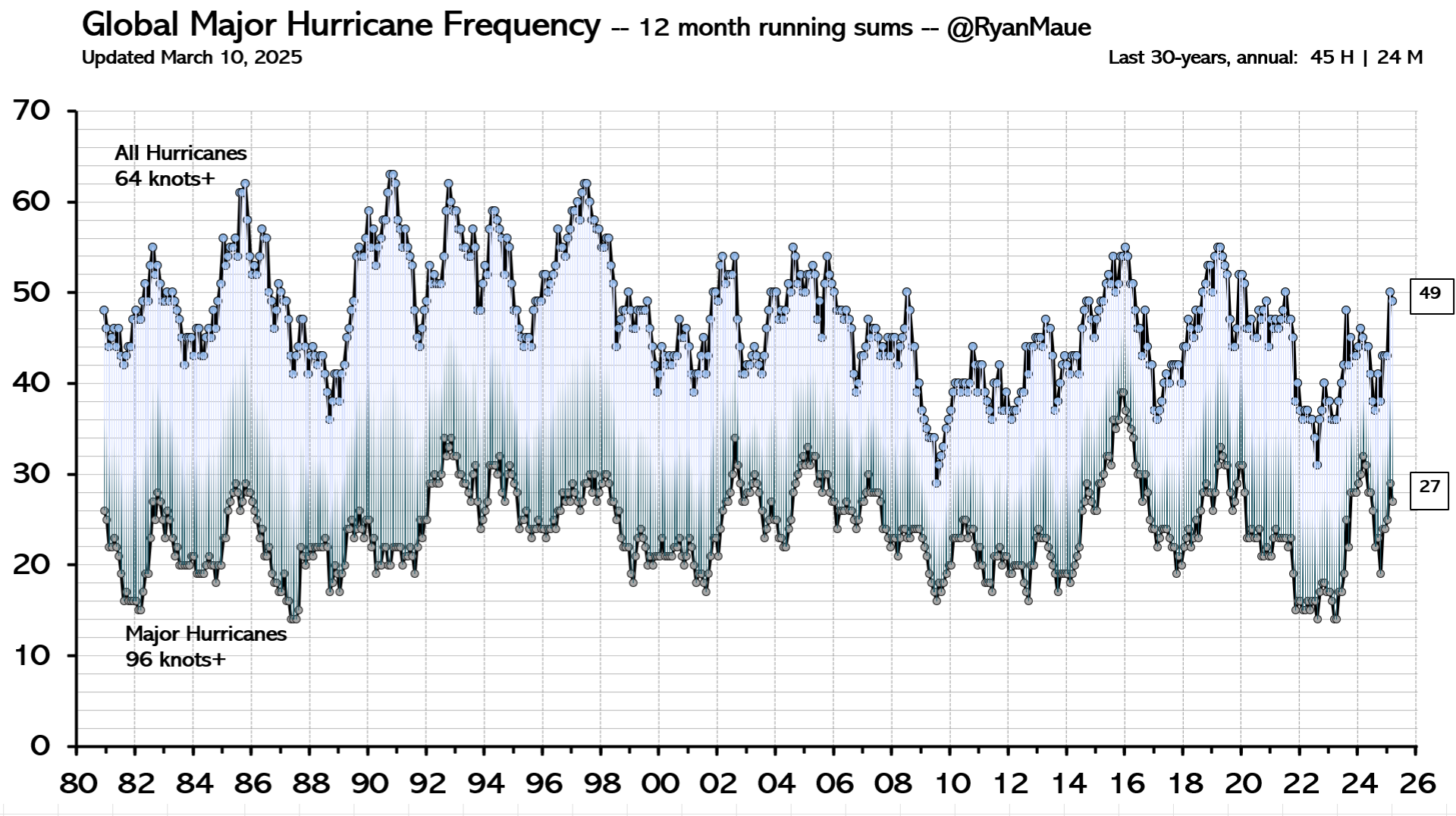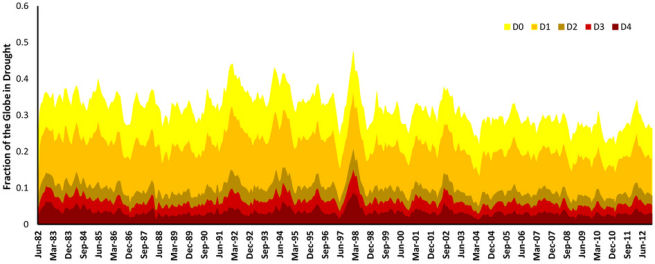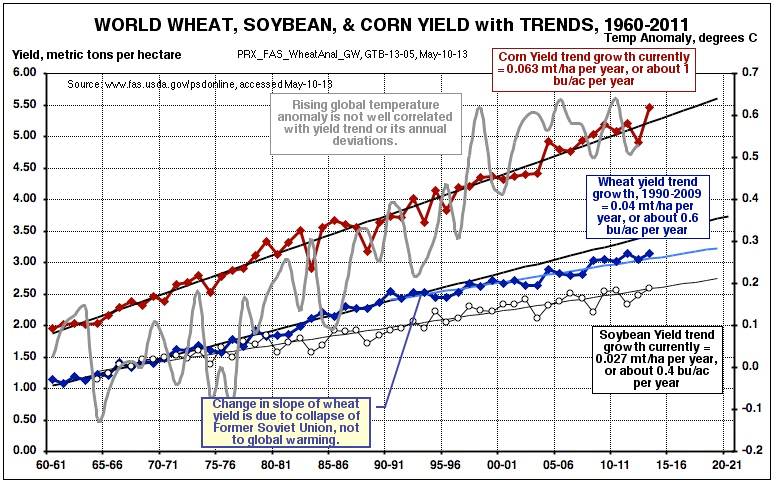Relative humidity is the fraction of water vapour in a small parcel of air relative to the total amount of water vapour the air could contain at the given temperature and pressure. All the General Circulation Models, also known as Global Climate Models (GCM), just set various evaporation and precipitation parameters to achieve approximately the result: Relative humidity = constant.
Box 8.1 of 4AR Chapter 8 page 632 states:
The radiative effect of absorption by water vapour is roughly proportional to the logarithm of its concentration, so it is the fractional change in water vapour concentration, not the absolute change, that governs its strength as a feedback mechanism. Calculations with GCMs suggest that water vapour remains at an approximately constant fraction of its saturated value (close to unchanged relative humidity (RH)) under global-scale warming (see Section 8.6.3.1). Under such a response, for uniform warming, the largest fractional change in water vapour, and thus the largest contribution to the feedback, occurs in the upper troposphere.
The assumption of constant relative humidity is not correct. Here is a graph of global average annual relative humidity at various elevations in the atmosphere expressed in millibars (mb) from 300 mb to 700 mb for the period 1970 to 2022. [Standard atmospheric pressure = 1013 mb. 1 mb = 1 hectopascal (hPa)] The data is from the NOAA Earth System Research Laboratory here.

This graph shows that the relative humidity has been dropping to about 2012, especially at higher altitudes allowing more heat to escape to space. The curve labelled 300 mb is at about 9 km altitude, which is in the middle of the predicted (but missing) tropical troposphere hot-spot. This is the critical elevation as this is where radiation can start to escape without being recaptured. The average relative humidity at this altitude has declined from 1970 to 2012 then increased to 2022! The decline from 1970 to 2022 was 9.3% (or 4.1 percentiles).
This is no logical reason to expect relative humidity to remain constant with increasing CO2 above the cloud layer. Relative humidity in a cloud is exactly 100% because the water droplets that make up the cloud are in equilibrium with the air. Likewise, relative humidity immediately above the oceans is 100%. The relative humidity in air parcels moving up over mountains will increase up to 100% causing rainfall. This saturation limit controls the average humidity in the atmosphere up to the top of the cloud layer. But the relative humidity at 400 mbars averages only 37% globally, or 31% in the tropics, and rarely gets anywhere near the saturation limit except in high thunderstorm clouds. The saturation limit therefore plays little role in determining the water vapour content of the upper atmosphere.
Doubling the amount of CO2 would increase temperatures by only about 1 degree Celsius if nothing else changed according to the IPCC. But the amount of water vapour will change in response to a CO2 induced temperature increase. Warmer air can hold more water vapour, so if relative humidity remains constant, the amount of water vapour increases with increasing temperatures. More water vapour, being a powerful greenhouse gas, would cause a further temperature increase, which is called a positive feedback. Most of the IPCCs projected warming is due to this water vapour feedback.
But the above graph shows falling relative humidity where the IPCC says changing water vapour content is most important. If relative humidity declines with increasing CO2 concentrations, the amount of water vapour in the upper troposphere may not increase, but might decline instead, resulting in a negative water vapour feedback.
Here is a graph of specific humidity, or the actual water vapour content, in grams of water vapour per kilogram of air, at the 400 mb level (about 8 km altitude).

This shows that the actual water vapour content in the upper troposphere has declined to 2012 then increased through 2020. The climate models predict that humidity will increase in the upper troposphere, but the data shows a large decrease until 2012; just where water vapour changes have the greatest effect on global temperatures. It is unknown why there was a dramatic change in the slope at about 2012.
The NASA water vapour project (NVAP) uses multiple satellite sensors to create a standard climate dataset to measure long-term variability of global water vapour. The Heritage NVAP merges data from several satellites and radiosonde water vapour products for the years 1988 to 2001. The graph below left was presents at the GEWEX/ESA Due GlobVapour workshop March 8, 2011 here. Water vapour content of an atmospheric layer is represented by the height in millimeters (mm) that would result from precipitating all the water vapour in a vertical column to liquid water.

The graph shows a significant decline in global water vapour in the atmosphere layer from 500 to 300 hPa, about 6 to 9 km altitude.

The animation above shows the amount of water vapour over the earth in the 500 to 300 mbar pressure layer. The Heritage NVAP global water vapour data (1988 to 2001) by layer is available from a NASA website here.
The global annual average precipitable water vapour by atmospheric layer and by hemisphere is shown in the follow graph.

The graph is presented on a logarithmic scale so the vertical change of the curves approximately represents the forcing effect of the change. The water content of the L1 layer, surface to 700 mb, is about 20 times greater than in the L3 layer, 500 to 300 mb, whereas the forcing effect of a change in the L3 is approximately 14.5 times the same change in the L1. Water vapour changed from 1990 to 2001 by -0.55 mm for L3, -0.57 mm for L2 and +1.73 mm for L1. The decrease in L3 is equivalent to an 8 mm reduction in L1. The water vapour decline in the L2 and L3 layers overwhelms the forcing effect of the water vapour increase in the L1 layer, so the water vapour feedback is negative. The upper atmosphere (L2 and L3) water vapour content of the southern hemisphere is less than, and has declined more than the water vapour content of the northern hemisphere.

The above graph shows the precipitable water vapour by layer versus latitude by one degree bands. The highest water vapour content at each atmospheric layer occurs near the equator.
Dr. Ferenc Miskolczi performed computations using the HARTCODE line-by-line radiative code to determine the sensitivity of the out-going long-wave radiation (OLR) to a 0.3 mm change in precipitable water vapour in each of 5 layers of the NVAP-M project. Note that a 0.3 prmm of water vapour is equivalent to 0.3 kg/m2 of water. The change of OLR for each layer is the difference between a reference case and a case with an additional 0.3 prmm ow water vapour in that layer. The reference case has 410 ppmv of CO2 in all layers and up to 70 km altitude. THe amount of water vapour in each layer up to 300 mbar is the average over 1970 to 2018 from the NOAA NECP1 dataset, and from the TIGR2 radiosonde dataset above 300 mbar.

The results show that a water vapour change in the 150-100 mbar layer has 284 times the effect on OLR than the same change in the 1013-1000 mbar near-surface layer. A water vapour change in the 300-250 mbar layer has 149 times the effect on OLR than the same change in the 1013-1000 mbar near-surface layer.
The table below shows the precipitable water vapour for the three layers of the Heritage NVAP and the CO2 content for the years 1990 and 2001, and the change.
Layer
|
L1 near-surface
1013-700 mbar |
L2 middle
700-500 mbar |
L3 upper
500-300 mbar |
Sum
L1+L2+L3 |
CO2
|
| 1990 |
18.99 mm |
4.6 mm |
1.49 mm |
25.08 mm |
354.16 ppmv |
| 2001 |
20.72 mm |
4.03 mm |
0.94 mm |
25.69 mm |
371.07 ppmv |
| change |
+1.73 mm |
-0.57 mm |
-0.55 mm |
+0.61 mm |
+16.91 ppmv |
Calculations show that the cooling effect of the water vapour changes on OLR is 16 times the warming effect of CO2 during this 11-year period. The cooling effect of the two upper layers is 5.8 times the warming effect of the lowest layer.
These results highlight the fact that changes in the total water vapour column, from surface to the top of the atmosphere, is of little relevance to climate change because the sensitivity of OLR to water vapour changes in the upper atmosphere overwhelms changes in the lower atmosphere. See here.
The NVAP-M project extends the analysis to 2009 and reprocesses the Heritage NVAP data.
The global total precipitable water vapour column from here is given below. Climate models assume that water vapour increases with increasing CO2 concentrations, but the NVAP-M data, using the best available satellite data, shows no increase in the total water vapour column.

The most obvious way to determine the water vapour feedback due to CO2 changes, i.e. the effect that CO2 changes have on upper atmosphere water vapour, is to plot the annual water vapour specific humidity versus CO2 concentrations. Annual data is used to eliminate the seasonal signal. The climate models show that the maximum predicted water vapour feedback is at about the 400 mbar pressure level, which is in the predicted but missing tropical troposphere hot spot as shown in the Heating of the Troposphere section above.
It has been suggested that the early NOAA Earth System Research Laboratory data is unreliable due to poor coverage and calibration issues. Water vapour in air immediately above the ocean is in equilibrium with the water, so the air is near 100% relative humidity, regardless of the temperature. Water vapour over land is expected to vary proportionally with water vapour over the oceans, resulting in a near constant global average relative humidity near the surface with global warming. Data before 1960 is considered less reliable because the surface relative humidity is too high and would result in a declining relative humidity trend. The graph below shows the relative humidity near the surface at 1000 mbar pressure from the NOAA database from 1960 to 2014. The best fit trend line shows no trend confirming that the NOAA water vapour data from 1960 has no drying bias near the surface. Therefore, we use only the data from 1960 in the analysis.

The graph below shows the annual specific humidity at the 400 mbar pressure level by three latitude bands. Note that in the tropics there is a significant drying trend. There is very little trend in either the northern or southern mid-latitude regions.

The graph below shows the global average annual specific humidity at the 400 mbar pressure level versus CO2 concentration from 1960 to 2021.

The blue line shows that as CO2 increases, water vapour decreases, which is opposite to climate model predictions. The brown line shows what the specific humidity would have been at the actual measured temperature assuming the relative humidity was held constant at the 1960 value.
The graph below shows the annual specific humidity in the tropics from 30 degrees North to 30 degrees South latitude at the 400 mbar pressure level versus CO2 concentration from 1960 to 2021. This is in the middle of the predicted but missing tropical hot spot.

Note the greater discrepancy between the actual data and the constant relative humidity assumption in the tropics versus the discrepancy for the global average. The brown line shows what the specific humidity would have been assuming a constant relative humidity. The actual climate model projections would show a much greater increase in specific humidity than indicated by the brown line because the climate models, in addition to the incorrect constant relative humidity assumption, also project the temperature increase in the upper atmosphere to be four times greater than the actual temperature trend determined by radiosonde and satellite measurements.
To compare this correlation to the climate model assumptions, the following graph shows the annual specific humidity in the tropics from 30 degrees North to 30 degrees South latitude at the 400 mbar pressure level versus temperature from 1960 to 2013. The climate models assume that water vapour changes only in response to a temperature change. If this were true, this graph should show a very strong correlation of increasing humidity with temperature. The graph is a phase space plot of the data points connected in time sequence. Over short time periods, an increase in temperature causes an increase in specific humidity. The annual data shows linear striations increasing from bottom left to top right, confirming that higher temperatures relate to higher specific humidity over short time intervals. But the overall trend is down, proving that specific humidity in the upper atmosphere declines with increasing temperatures over longer time scales.

The graph not only shows a very poor correlation of specific humidity to temperature at the 400 mbar pressure level, but the trend is negative rather than strongly positive as assumed in the climate models. Increasing CO2 would initially cause a slight warming before considering a water vapour or cloud response. In climate models this warming causes an increase in upper atmosphere water vapour because the models assume that water vapour can only change in response to a temperature change. But the data shows that water vapour declines with increasing CO2 at a R2 correlation of 0.73 and shows that water vapour declines with temperature at a R2 correlation of only 0.027. Obviously specific humidity is not only responding to temperature changes. In the long-term, factors other than temperature determine upper atmosphere humidity. Temperature has little effect on the long-term upper atmosphere specific humidity contrary to climate model assumptions. CO2 emissions are causing a decline in upper atmosphere water vapour thereby allowing heat to escape to space. We believe that the long-term specific humidity in the upper atmosphere is determined by the maximum entropy principle, not temperature. The atmosphere is able to maximize the loss of heat to space subject to the constraint of the saturation limit in the lower atmosphere by decreasing the water vapour content in the upper atmosphere in response to increasing CO2 concentrations.
The NOAA humidity data is here in Excel format.
The graph below compares the IPCC AR5 hindcast/forecast multi-model mean to the NOAA total precipitable water vapour column anomaly. It also shows that water vapour changes lag behind ENSO by about 3 months. The graph is from a blog comment by Bill Illis here.

The AGW theory is essentially the idea that an increase in CO2 will cause water vapour to increase causing an enhanced greenhouse effect. The graph shows that the models roughly agrees with observation to 1984, then the models significantly over estimates the total water vapour content of the atmosphere. The modellers apparently make no attempt to match observations after 1984.
Greenhouse gases absorb long-wave radiation, making the atmosphere opaque at those wave lengths. Dr. Ferenc M. Miskolczi has developed a program called High-resolution Atmospheric Radiative Transfer Code (HARTCODE) that uses thousands of measured absorption lines and is capable of doing accurate radiative flux calculations. The calculations are independent of any greenhouse theory and contain no assumptions on how the greenhouse effect works, other than the fact that greenhouse gases absorb and emit radiation.
Water vapour is the most important greenhouse gas. HARTCODE simulations show that a 10% increase in CO2 concentration has the same effect as a uniform 1.80% change in water vapour on the out-going longwave radiation (OLR). A uniform 1% change in water vapour has 5.4 times the effect that a 1% change in CO2 has on OLR. A doubling of CO2 can be offset by a 12.3% reduction in H2O. This is shown in the following graph.

The radiation balance is determined at the top of the troposphere. The HARTCODE was used to determine the effect of changes of water vapour at the upper atmosphere versus near the surface. The graph below shows that changing the water vapour content in an atmospheric layer from the 300 mb to the 400 mb level has 30 times the effect on out-going long-wave radiation (OLR) as the same small change near the surface. So water vapour changes in the upper atmosphere are more important than changes in the lower atmosphere.

Optical depth is a measure of how opaque the atmosphere is to long-wave radiation, and so is a measure of the strength of the greenhouse effect. Miskolczi used HARTCODE to compute the optical depth from 1948 to 2008 using the measured CO2 content at Mauna Loa, Hawaii and the global average water vapour content from the NOAA Earth System Research Laboratory. The optical depths are calculated for each greenhouse gas and summed line-by-line across the electromagnetic spectrum. The resulting optical depth curve is a measure of the total greenhouse gases by effect over the last 61 years. The result is given below.

The blue line of the graph shows the optical depth of the atmosphere with changing CO2 and water vapour content. The green line is the linear trend of this data which indicates an insignificant trend. The pink line is the effect of increasing CO2 with water vapour held constant. It shows a small upward trend. The difference of these trends is the water vapour feedback. Recall that the IPCC assumes that water vapour provides a large positive feedback, which implies that the green line would be increasing much steeper than the pink line. The HARTCODE results shows the opposite. It shows a large negative feedback, where the changing water vapour offsets most of the warming effect of CO2.
The results show that the total effective amount of greenhouse gasses in the atmosphere has not significantly increased over the last 60 years.
The IPCC claims that the warming over the last half century was due to an increase in the quantity of greenhouse gases in the atmophere. But the HARTCODE result shows that CO2 replaces water vapour as a greenhouse gas, so it can't be responsible for global warming.
Here is the GCM error of specific humidity as reported by the IPCC's 4AR, Chapter 8-Suppl page 54:

This chart shows the multi-model mean fractional error, expressed as a percent (i.e., simulated minus observed, divided by observed and multiplied by 100). The observational estimate is from the 40-year European Reanalysis (ERA40, Uppala et al., 2005) based on observations over the period 1980-1999. The model results are from the same period of the CMIP3 20th Century simulations.
Note that the chart shows that the model's errors in specific humidity at the altitude where the largest contribution of the feedback is predicted to occur is between 20% to 400 too high! If the specific humidity were corrected in the models at this critical altitude, the positive feedback would change to a strong negative feedback.
The strength of the greenhouse effect is undetermined in the current theory utilized by climate models. Parameters are just set to match the current temperatures. A new greenhouse effect theory by Ferenc Miskolczi shows that the current greenhouse effect equations are incomplete because they do not include all the necessary energy constraints. When these constraints are included in a new theory, the strength of the GHE is determined analytically. The new theory presented in Miskolczi's paper shows that the atmosphere maintains a saturated greenhouse effect, controlled by water vapour content. There is a near infinite supply of greenhouse gases available to the atmosphere in the form of water vapour from the ocean to provide the greenhouse effect, but the atmosphere takes up only a portion of the water vapour it could hold due to energy balance constraints. Adding CO2 to the atmosphere just replaces an equivalent amount of water vapour to maintain an almost constant greenhouse effect and has negligible effect on global temperatures. See here for more information.
























